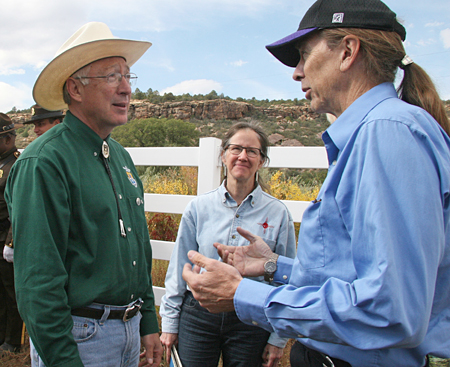
Photo: Margaret McKinney/Highlands University
U.S. Secretary of the Interior Ken Salazar, left, talks with Highlands University President Jim Fries at the dedication of the Rio Mora National Wildlife Refuge Sept. 27. In the background is Sherry Thompson of the Thaw Charitable Trust.
Las Vegas, N.M. — U.S. Secretary of the Interior Ken Salazar dedicated the new Rio Mora National Wildlife Refuge Sept. 27, lauding New Mexico Highlands University for its environmental research at the refuge’s Wind River Ranch location.
The new 4,224-acre wildlife refuge near Watrous, N.M. is in a transition zone where the Great Plains meet the Sangre de Cristo mountains of the southern Rocky Mountains. The Mora River flows through the property, sometimes framed by steep canyon walls.
In 2005, Santa Fe philanthropists Eugene and Clare Thaw established the Wind River Ranch Foundation to preserve their land’s southwestern ecological heritage through restoration, research and education. Wildlife biologist Dr. Brian Miller was a founder of Wind River Ranch and its first executive director.
The Thaws donated the ranch to the U.S. Fish and Wildlife Service, protecting the land forever as the Rio Mora National Wildlife Refuge.
“This place will become a mecca for environmental education and research in New Mexico and the U.S. through Highlands University and other partnerships,” Salazar said. “Today we are taking a very significant step in creating the 21st century conservation agenda.
“Highlands University can use this new refuge as a linchpin to make sure we are making good conservation decisions. Highlands’ ongoing research goes hand-in-hand with this ranch, and together we can learn how to take better care of our planet,” Salazar said.
Highlands University faculty conducting research at Wind River Ranch with their students include biology professors Jesus Rivas, Sarah Corey Rivas, and Richard Plunkett; natural resources professor Edward Martinez, and forestry professors Craig Conley and Sara Brown.
Research has covered topics as diverse as the classification of ecological zones at the ranch, including a genetic study of the ranch’s bison herd, the response of native aquatic fauna like the leopard frog to removing the invasive non-native bullfrog, and a study of bird diversity on the ranch’s grassland, to name a few.
Wind River Ranch’s location 30 minutes from Highlands makes it accessible for fieldwork. The research analysis takes place in the university’s science laboratories.
“Wind River Ranch has been a valuable center for K-20 education and ecological research,” said Highlands University President Jim Fries. “Establishing the Rio Mora National Wildlife Refuge will only enhance the ranch’s value as a research site for Highlands’ faculty and students. We are pursuing federal grants aimed at establishing a permanent Highlands field station at the refuge for ecology, restoration and conservation studies.”
Fries said the new refuge is an outstanding example of collaborative efforts bringing diverse groups together to create something greater than any one group could accomplish on its own.
“Doing fieldwork at Wind River Ranch has put joy into scientific discovery for our students, and having a rich, dynamic ecological field site so nearby supports a culture of research,” Corey-Rivas said. “For example, it’s a really unique opportunity for students to study endangered bison, the last remaining megafauna in our American landscape. It’s easy for students to connect with the bison and care about their conservation, making it a golden incentive for them to dive into research and make a real contribution to science.”
Miller established a bison conservation herd at Wind River Ranch through a partnership with the Inter Tribal Buffalo Council.
“The Highlands professors have made a strong commitment to researching the ecological health of the ranch while also investigating the role of highly interactive species in maintaining a healthy, functioning ecosystem,” Miller said. “Their scientific expertise is invaluable.”
Robert Ortega, a graduate student in natural resources management, has participated in several Highlands University research studies at Wind River Ranch.
“It was an amazing research opportunity at Wind River to see the different species in their natural habitat,” Ortega said. “After less than a year of removing the invasive, non-native bullfrogs from a section of the Mora River, we’re seeing more of the native leopard frogs.”
The Rio Mora National Wildlife Refuge will be managed as part of the Northern New Mexico National Wildlife Refuge Complex that includes the Las Vegas and Maxwell National Wildlife Refuges. Rob Larranaga manages these two existing refuges and will provide oversight and guidance for the Rio Mora refuge.
“We saved a magnificent section of the Mora River Valley for wildlife, for people, forever,” Larranaga said. “A vision for this new refuge is to conduct science-based research, and educate future natural resource managers and conservation professionals. Highlands is an important part of this vision.
“We have excellent rapport with the science professors at Highlands through an ongoing research and internship partnership at the Las Vegas refuge. The Highlands students are high caliber and provide valued boots-on-the-ground assistance to gather important land management data,” Larranaga said.
